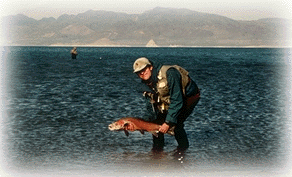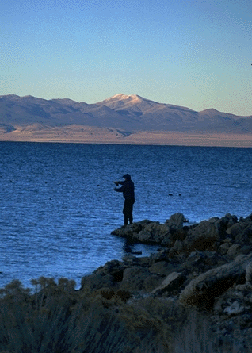
 Pyramid Lake
Pyramid Lake
Pyramid Lake is the ancestral home of the Lahontan Cutthroat that used to range
up the entire range of the Truckee into LakeTahoe and its tributaries. The last
natural spawning run of these fish was in the 1930s after a diversion dam was
placed on the
Truckee for the benefit of agriculture.
This fishery has been preserved by the Paiute Tribe on whose land the Lake lies.
Through their excellent hatchery program this lake remains the last chance for
many western anglers to catch a double-digit trout.
There are several aspects to the culture of fishing at Pyramid lake that may
take the angler a couple of trips to appreciate. First of all, this is desert.
The lake is at about 4000 feet; there are no trees; the lake is alkaline; its
color is pastel blue. Secondly, standard equipment includes a 5 foot aluminum
ladder. The fish come into the shallows and this added altitude provides the
angler a good view and longer casting range. Finally, the fish, are beautiful,
none too smart, and can be caught in large quantity and occasionally large size.
The season runs for October 1 to June 30th each year. You can purchase either
a season pass or day passes. It is best to the weather before coming, especially
if it has been hot and the season is off to a slow start. In general the early
season, October and November is noted for large numbers of small fish -- note
that small here usually means 17-20". The winter months, however, see the big
fish come in. The problem with winter at 4000 feet should be obvious. You'll
need heavy waders, preferably down clothing or something serious to keep you
warm, and some protection for the hands. Of course the biggest fish I've landed
here was during a winter storm with 3' waves.

Along the edge of the lake there are a series of ledges or drop-offs. There are easily seen as color changes. The fish often patrol these hitting anything that comes across. Your mission is to cast across and strip the flies in to mimic the baitfish. If one stands on a ladder or milk box and wears polarizing lens one is often in for the shock of seeing the fish actually take the fly 10' in front of you. A last hesitation or twitch will often be the difference between a take and a refusal. The disadvantage of the ladders and boxes is that if you can see them, guess what, they can see you. I don't wear any pink hats out there.
There are important safety precautions to take. The most important of which is watch where you're wading. It's easy to step off a ledge. People have drowned here. Also, don't forget the wading belt. Rarely people will float tube -- if the wind changes, you may be in for an ocean voyage to the other side of the lake.
The most popular location around the lake is probably just below the hatchery at Sutcliffe. It is not unusual for dozens of anglers to be perched on ladders here. I think it is best to move about and if nothing is happening in two hours or so, try another spot. If one dutifully stays anchored to one's ladder, eventually some fish are likely to pass by, but they travel in schools along the shore and they may only be around for a few minutes -- sheer pandemonium. You may see fish behind your ladder.
A technique I have tried with success is simply to prowl the coast in a lonely spot casting and moving in one direction until I hit some fish. If the fish move parallel to the shore back and forth, eventually you'll hit some if you move consistently in one direction. Most recently I have been using a Spey Rod for this and it makes it very easy. It can also be accomplished with the standard rig an 8 wt with shooting head (many people also use lighter rigs and spin gear). I find this more interesting than sitting on a ladder.
Most people wisely stay close to the paved roads. However, tales of the great fishing available of the eastern side of the lake or elsewhere can be enchanting. One absolutely has to remain on guard for loose sand. At one point on the east side I was seen driving my Subaru around in circles for fear of stopping and never moving again in the loose sand. They may not find you for days out there....
The flies used are generally not too sophisticated, i.e. Wooly Buggers or Worms. A good rig used locally is two flies: the first is a bright color (the attractor) followed 36" later by a dull color (the bait) that the fish usually takes. There are lots of small baitfish seen in the shallows. My favorite colors are, believe it or not, purple and chartreuse. When tying make your buggers worms by not tying the tails too long -- a great cause of a missed strike.

Story and photos by Jerry Yesavage
Return HOME

Visit our Tahoe Country in
Heavenly Village, South Lake Tahoe. (
map)
Or, shop Online
(c)1996-2004 Tahoe Country

 Pyramid Lake
Pyramid Lake

